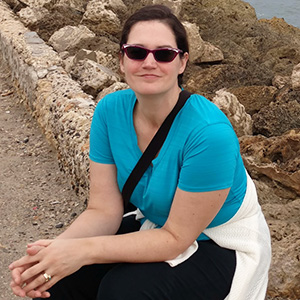
Anita Gutierrez
As the principal curriculum developer for a company that develops estimating and accounting software for the construction industry, Anita Gutierrez isn’t the typical student of San Diego State University’s online Construction Professional Certificate program.
“I was looking for a way to enhance my subject matter knowledge in the most efficient way possible,” said Gutierrez, who works for Sage Software in Portland, Oregon. “At first I thought it was counter-intuitive that one could ‘study’ construction in online classes — but to my delight, there is so much to learn by engaging with the other students and very knowledgeable, experienced instructors. The discussion format of the classes is invaluable, as we get so many perspectives, anecdotes, and experiences — group discussions and personalities really develop quickly and make the courses a lot of fun.”
Gutierrez’s journey toward her career was as atypical as her reason for taking SDSU’s construction online courses. She answered a few questions about her journey and SDSU’s program.
Please give us a brief history of your education and career.
You could say I took the scenic route to the real world. In college, I majored in comparative literature, and then attended a graduate program in literary criticism and theory. My plan was to be a professor of English literature — but after a few years it was clear that the academic life was not for me. During my studies in literature, I’d developed a secret hobby: developing a software application to organize all of my notes on literature and philosophy, including impressions of each book I read, details about authors, titles, keywords, and even a self-updating historical timeline — everything I needed to finally write that dissertation (which didn’t happen). So my education left me with very strong critical reading abilities, honed writing skills, no vocation, and a software habit. My first job outside of academia was as an office manager at a software company. Once my foot was in the door, I found ways to learn the skills I needed to launch a career in technical writing. Almost 20 years later, as a curriculum developer, I’m still writing, teaching, and learning — and now I don’t have to hide my software habit!
Do you partner with a construction client first to develop custom software or do you develop software based on the general needs of the industry?
My company champions small- and medium-sized businesses, developing software to help them succeed and thrive. We have an incredible team of business analysts who work with construction clients to understand their needs, dreams, and pain points, and translate what they learn into better software. By the time I see the features in each new release, that work has already been done. My job is to prepare our certified trainers and support analysts to assist our customers in making the software work for them. So, there are several layers between me and our customers — but I know that in order to design effective curriculum materials for construction operations, I have to empathize with the people swinging hammers, scheduling subs, cross-checking prints, and running numbers. That’s what led me to seek classes in the construction field.
Which courses did you take in SDSU’s online Construction program?
I completed Construction Blueprint Reading, Construction Materials and Processes, Introduction to Construction Estimating, and Essential Construction Math. In the next term I’ll take Contract Documents and Construction Law. I’m very excited about that one because so much of our software is focused on tracking vital project documentation. I hope to continue studying with SDSU to complete the certificates in Construction Estimating, Construction Practices, and Civil Sitework Construction — but I can only fit one course per term into the cracks between life and work, so it may take a while.
Can you give a specific example of how the courses helped you attain your goal of enhancing your subject matter knowledge?
We have training materials for our estimating software, but they are quite outdated and I don’t believe they fit well with the methods estimators use in real life. My first SDSU course was Construction Blueprint Reading, and by the third week I was already thinking of ideas for how we could overhaul our estimating training to make it more relevant to customers.
Can you speak to the quality of the instruction?
Really great. The instructors have a vast amount of knowledge in their subject areas, and are always ready with anecdotes or experiences that illustrate whatever topic we’re discussing. The amazing thing, though, is that they’re able to sit back and let class participants reason through problems and questions, share perspectives, and learn from one another instead of jumping in too often. As a former university instructor, I know how hard — and important — it is to do that!
Can you elaborate on the discussion format of the classes?
The class participants represent so many different trades and industries — with each new discussion topic there are always people who have direct firsthand experience with some aspect of it. So far I have met electricians, interior designers, document managers, carpenters, real estate developers, and even someone with underwater welding experience! Last term, one of the students was an architect who had recently moved to the U.S. from Medellín, Colombia. As it happened, I had planned a three-week trip to visit family in Colombia in the middle of that term! I had been to Colombia before, but because of this student’s perspective, I arrived with a new curiosity about the different types of construction and design — from urban skyscrapers to the shanty-towns of indigenous families on the outskirts. I was able to post pictures and observations from my travels in the class discussions, especially based on pointers the Colombian student had provided.
What do you think are the program’s biggest strengths?
The online format makes it possible to participate from anywhere, which means we get an amazing variety of perspectives. And the instructors’ willingness to let participants run the discussions means we get the most possible value out of people sharing their experiences. It’s so easy for an instructor to shut down a conversation by chiming in too early or often — but that doesn’t happen at all in these courses.
Would you recommend the courses to others who do what you do or to those in the construction industry?
Absolutely — I already have spread the word within my organization. Our leadership team always encourages us to find ways to connect with members of the industry we serve. If I had to design a program that could help my colleagues learn about our customers in the most efficient and cost-effective manner, it would look a lot like SDSU’s program! As for those in the construction industry, one of the consistent themes in the discussions has been the value of understanding how other trades and disciplines depend on each other. Poor coordination of trades during planning and scheduling has been cited multiple times as the cause of issues down the line. The more people understand the key perspectives of various trades, the more likely it is that potential conflicts will be caught and addressed before they materialize. So yes, in discussions I heard many participants express the value the class was having for them.
How did you find out about SDSU’s online construction programs?
Once it became clear that I would be taking on more responsibility for the training materials related to our estimating and construction operations products, my manager suggested I see what I could find in the way of learning opportunities. From there it was a quick Google search.
Anything you’d like to add?
I guess I would circle back to my liberal arts education, which prepared me for whatever came next — and not for any specific thing! The field of construction is immense and diverse, and what’s true of liberal arts is also true of construction: You never know when some detail you spot, or problem you solve, or perspective you share, will be of real value to others, saving time, money, or even lives. These courses provide a broad foundation for understanding many aspects of the construction industry, which benefits everyone in the long run.




